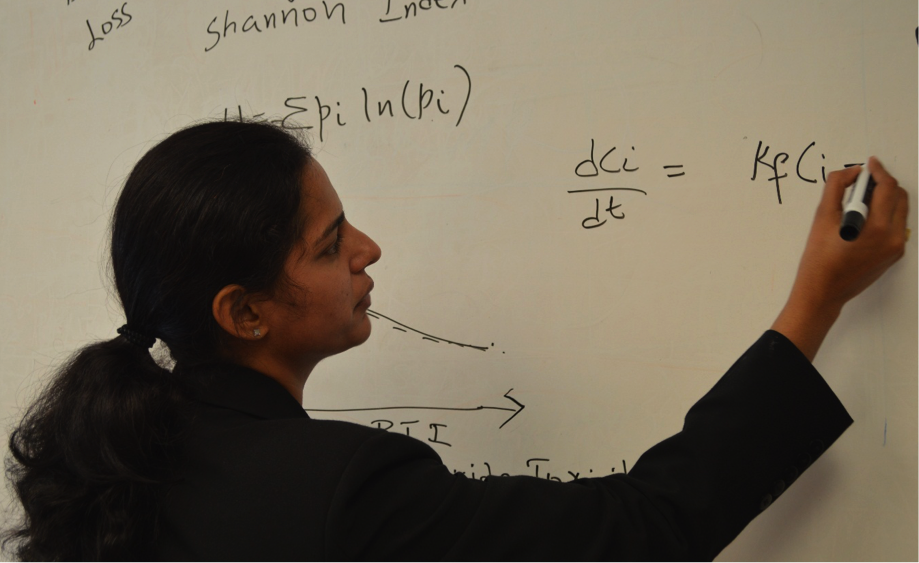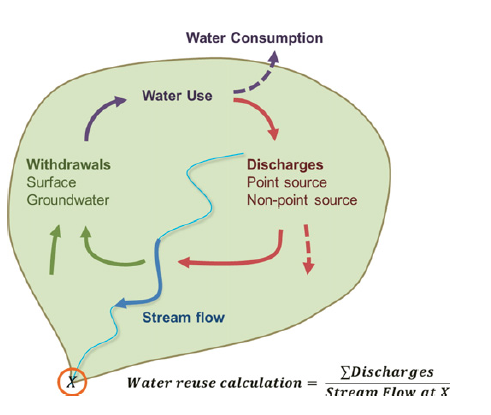EEE Research
EEE professor Shweta Singh is currently focusing her research on modeling Nitrogen and Phosphorus cycling in the Indiana Economy utilizing a systems scale Physical Input-Output Table (PIOT) based model. This model will enable coupling the economic N & P flows with ecological systems, thus enabling a coupled economic-ecological analysis for sustainable nutrient management. Other work in Dr. Singh’s group is identifying a mechanism-based model for biodiversity loss due to chemical pollutants. Such systems scale understanding of impact of chemical pollutants is currently missing and would provide insight into targeted pollutant control for preventing biodiversity loss. The overall goal of Dr. Singh’s research program is to develop systems goal models for coupled techno-ecological systems such as in N & P cycling or biodiversity and pollutant systems. Her research group consists of PhD students Daniel Bampoh and Liz Wachs.
Dr. Singh’s work on modeling interaction of Nitrogen cycle with Economy using an Economic Input-Output Model won best paper award at the Sustainable Engineering Forum at AIChE in 2014. She also spoke as an invited panelist on Global Energy Transitions at Singapore Energy Week, 2015, on the issue of sustainable energy provision for urban growth considering the effect of climate change.

EEE professor Loring Nies, along with professor Chad Jafvert, and Ph.D. student Maria Wiener, recently published a paper on Water Use in the Wabash River.
The abstract of the Publication reads:
 “Increasing demands for freshwater make it necessary to find innovative ways to extend the life of our water resources, and to manage them in a sustainable way. Indirect water reuse plays a role in meeting freshwater demands but there is limited documentation of it. There is a need to analyze its current status for water resources planning and conservation, and for understanding how it potentially impacts human health. However, the fact that data are archived in discrete uncoordinated databases by different state and federal entities, limits the capacity to complete holistic analysis of critical resources at large watershed scales. Humans alter the water cycle for food production, manufacturing, energy production, provision of potable water and recreation. Ecosystems services are affected at watershed scales but there are also global scale impacts from greenhouse gas emissions enabled by access to cooling, processing and irrigation water. To better document these issues and to demonstrate the utility of such an analysis, we studied the Wabash River Watershed located in the U.S. Midwest. Data for water extraction, use, discharge, and river flow were collected, curated and reorganized in order to characterize the water use and reuse within the basin. Indirect water reuse was estimated by comparing treated wastewater discharges with stream flows at selected points within the watershed. Results show that during the low flow months of July–October, wastewater discharges into the Wabash River basin contributed 82 to 121% of the stream flow, demonstrating that the level of water use and unplanned reuse is significant. These results suggest that intentional water reuse for consumptive purposes such as landscape or agricultural irrigation could have substantial ecological impacts by diminishing stream flow during vulnerable low flow periods.”
“Increasing demands for freshwater make it necessary to find innovative ways to extend the life of our water resources, and to manage them in a sustainable way. Indirect water reuse plays a role in meeting freshwater demands but there is limited documentation of it. There is a need to analyze its current status for water resources planning and conservation, and for understanding how it potentially impacts human health. However, the fact that data are archived in discrete uncoordinated databases by different state and federal entities, limits the capacity to complete holistic analysis of critical resources at large watershed scales. Humans alter the water cycle for food production, manufacturing, energy production, provision of potable water and recreation. Ecosystems services are affected at watershed scales but there are also global scale impacts from greenhouse gas emissions enabled by access to cooling, processing and irrigation water. To better document these issues and to demonstrate the utility of such an analysis, we studied the Wabash River Watershed located in the U.S. Midwest. Data for water extraction, use, discharge, and river flow were collected, curated and reorganized in order to characterize the water use and reuse within the basin. Indirect water reuse was estimated by comparing treated wastewater discharges with stream flows at selected points within the watershed. Results show that during the low flow months of July–October, wastewater discharges into the Wabash River basin contributed 82 to 121% of the stream flow, demonstrating that the level of water use and unplanned reuse is significant. These results suggest that intentional water reuse for consumptive purposes such as landscape or agricultural irrigation could have substantial ecological impacts by diminishing stream flow during vulnerable low flow periods.”
The article has gotten a lot of attention and has even been featured on WBBA http://wbaa.org/post/during-summer-indiana-uses-entire-volume-wabash-river
